
481
Item nr.
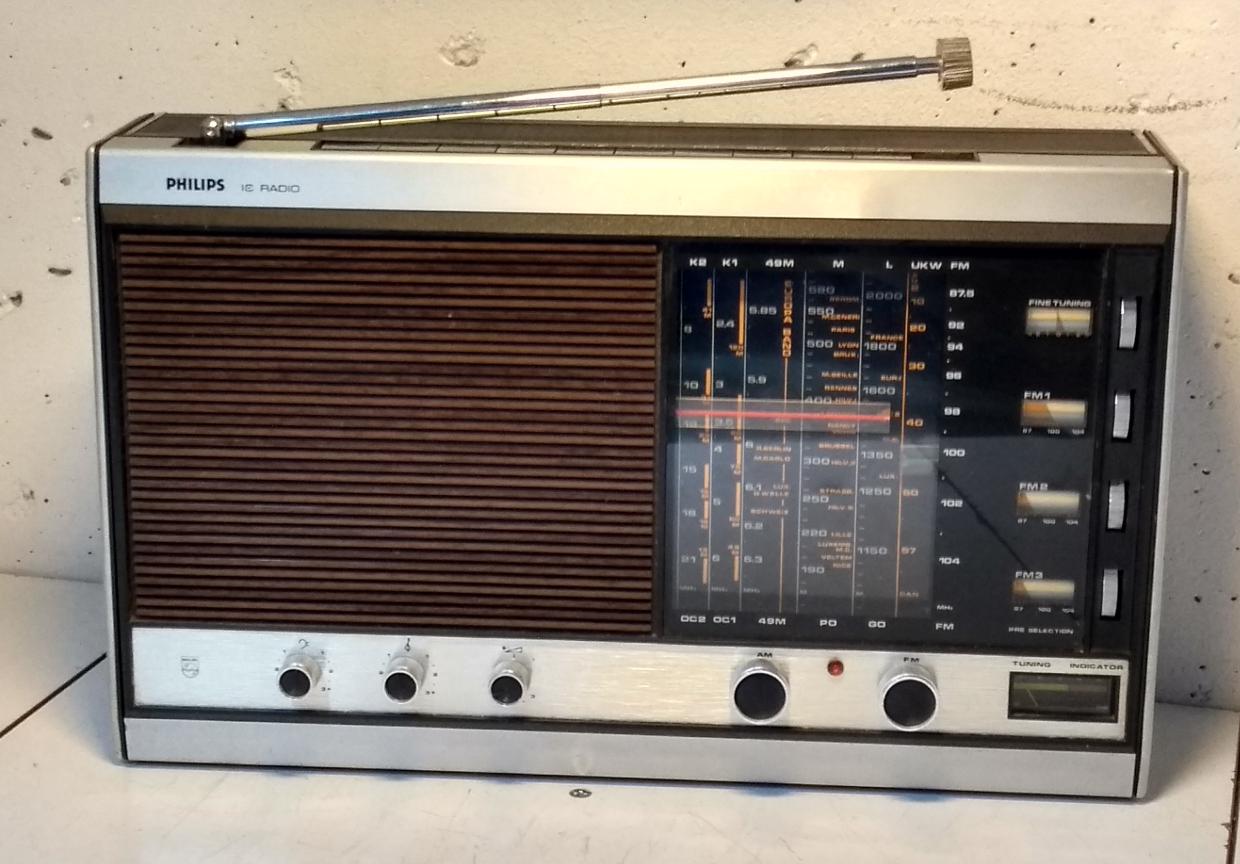
Philips 50IC361/00 Hurricane de Luxe
Here for something new: receiver ICs (FM works very well, AM doesn't).
Data for Philips 50IC361/00
| Production | Germany, 1971.
Price was DM348. |
|---|
| Bands | LW (148-262kHz), MW (517-1622kHz), TB (2.18-6.26MHz), 49m (5.89-6.26MHz), SW (7.03-21.97MHz), FM (87.5-104.5MHz); IF 452kHz and 10.7MHz. |
|---|
Semi-
conductors | TBA570. |
|---|
| Cabinet | Plastic.
Size 370x226x85mm.
|
|---|
| Power | AC 115/230V, batt 6xD. |
|---|
| Documents | Schema (from NVHR); longer version at DocTSF.fr; Philips 1972 flyer, p23. |
|---|
The Design
The Hurricane was produced 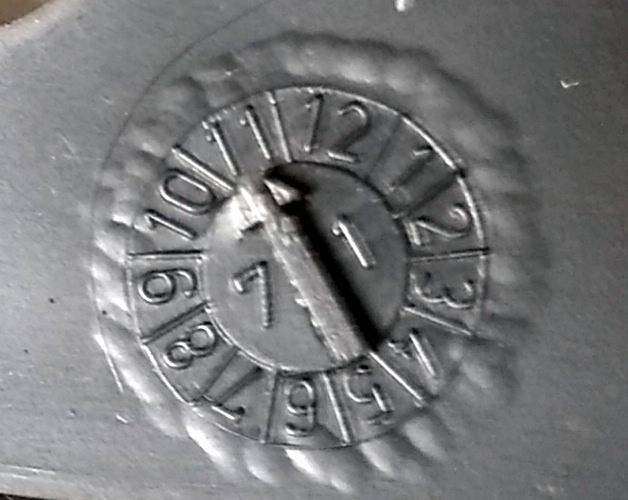 from 1971 to 1975, mine has an 11/71 date stamp.
from 1971 to 1975, mine has an 11/71 date stamp. The FM band was used only up to 100MHz in the first decade, and up to 104MHz until the early seventies. Full FM band radio's were illegal, because the higher FM frequencies were used for military purposes. Later Hurricanes (suffix /07) went to 108MHz. The power transformer must be of unusual quality, because it shows the lowest vampire draw I have ever observed in a radio± 0.4W only. So no need to replace anything here by switched mode supplies.
The HF part is based 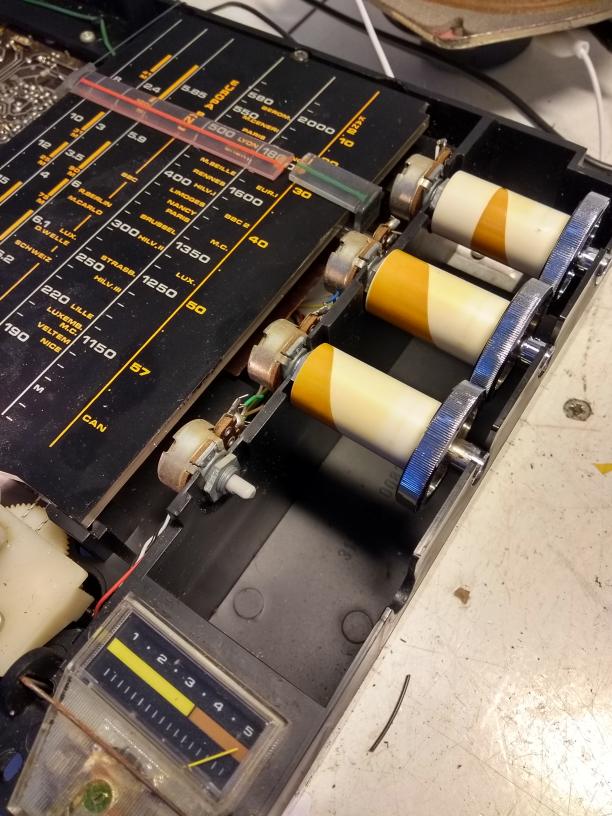 on the TBA570 IC. Radio ICs became common in the eighties, and seventies portables were usually equipped with discrete transistors. However, Philips Germany experimented with several models of IC radio's in the early seventies. Although it is fully analogue, it has a feature usually found in digital radio's, namely tuning by voltage and potmeters. FM is tuned with a 100k pot, giving a control voltage that regulates both the FM oscillator and the RF circuit.
on the TBA570 IC. Radio ICs became common in the eighties, and seventies portables were usually equipped with discrete transistors. However, Philips Germany experimented with several models of IC radio's in the early seventies. Although it is fully analogue, it has a feature usually found in digital radio's, namely tuning by voltage and potmeters. FM is tuned with a 100k pot, giving a control voltage that regulates both the FM oscillator and the RF circuit. 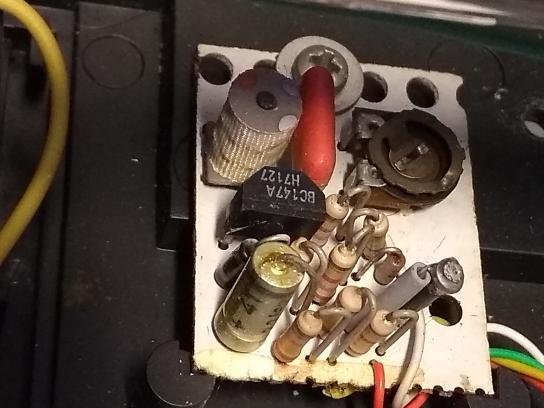 The necessary conrol DC voltage of 12.5V is derived from the main power of 9V by a small DC/DC-converter. By switching between four potmeters, you choose the main dial or one of the three presets. The five AM bands are tuned with a classical double variable capacitor, but the fine tuning is also by a potmeter. The photo left shows the three preset pots and the fine tuning pot (top).
The necessary conrol DC voltage of 12.5V is derived from the main power of 9V by a small DC/DC-converter. By switching between four potmeters, you choose the main dial or one of the three presets. The five AM bands are tuned with a classical double variable capacitor, but the fine tuning is also by a potmeter. The photo left shows the three preset pots and the fine tuning pot (top).
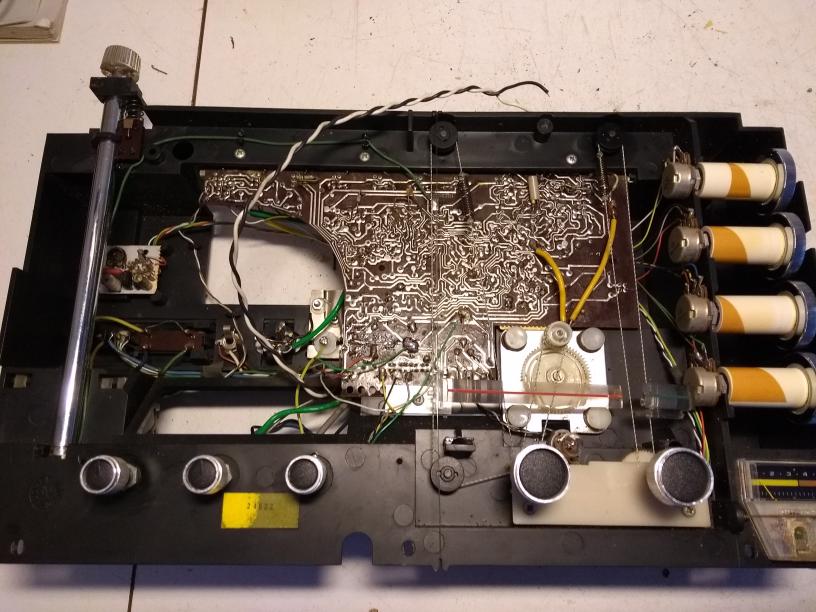
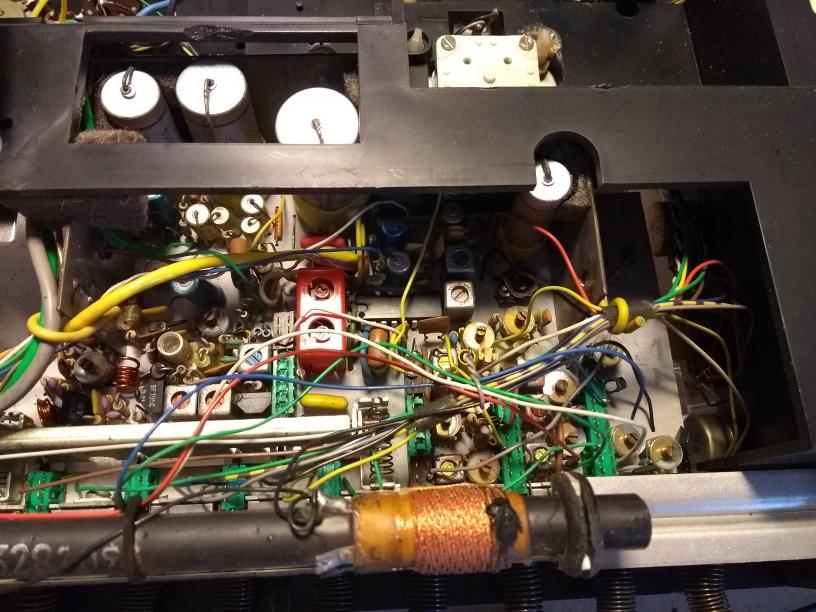 The PCB is equiped with miniaturized components, developed by Philips during the sixties. So, as you can see, the PCB only takes a relatively small part of the cabinet. Unlike modern designs, this radio has quite a lot of components that are not placed on the PCB, such as sound and tuning potmeters. So, you'll still find a lot of colored wires in this radio. The look of the radio slightly ressembles the Satellit 1000. Like the Satellits, this 50IC361 has pushbuttons that remain in the cabinet when pulling the chassis.
The PCB is equiped with miniaturized components, developed by Philips during the sixties. So, as you can see, the PCB only takes a relatively small part of the cabinet. Unlike modern designs, this radio has quite a lot of components that are not placed on the PCB, such as sound and tuning potmeters. So, you'll still find a lot of colored wires in this radio. The look of the radio slightly ressembles the Satellit 1000. Like the Satellits, this 50IC361 has pushbuttons that remain in the cabinet when pulling the chassis.
| Obtained | 6/2018
from NVHR Swap Meet; sn=WA24526. |
|---|
| Condition | 6; AM poor, antenna misses tip, S-meter and knob gone. |
|---|
| Disposed | Sold 5/2021. |
|---|
This Object
The radio had half of the antenna gone; the replacement I found for a few euro's in the next stall didn't match. To pull the chassis, first unscrew the five back screws, then the front comes off. You then must unscrew the chassis from the back. Three of the screw holes had broken from the cabinet, and I glued this with two component glue. I cleaned the cabinet and knobs with ammonia. The dial light was defective and I replaced it.
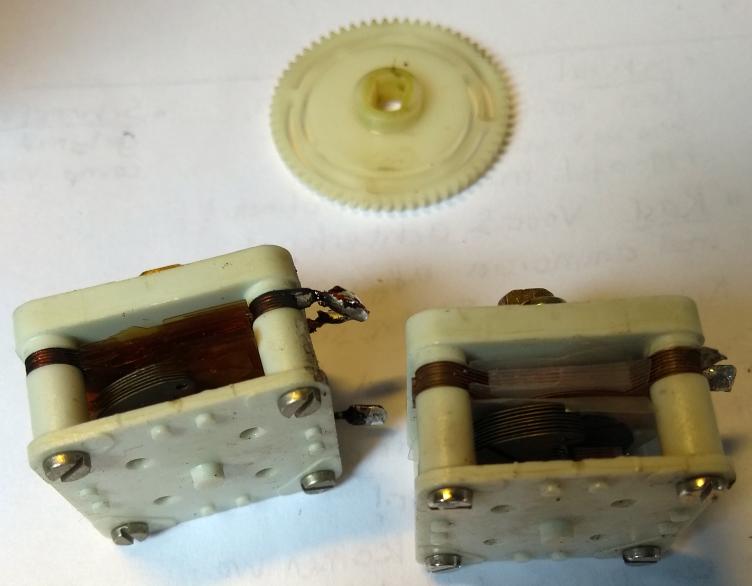
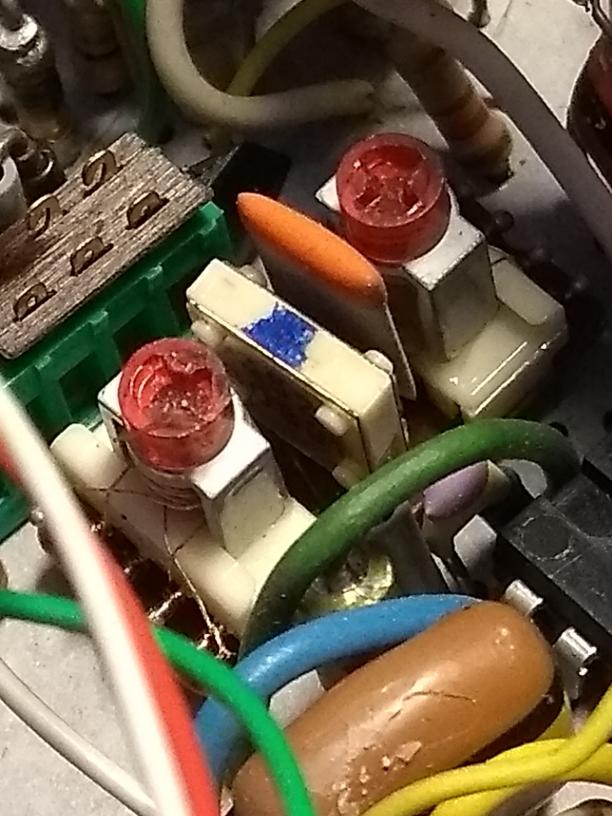 FM worked fantastic all the time, but the AM bands were dead barring some scratching and I discovered this to be due to a shorted tuning cap. The isolating dielectricum is a dark mica like stuff that brittles. Fortunately, a fellow collector sent me a good cap and I succeeded to bring the AM bands alive with that capacitor. The model was produced with different type of tuning capacitor, where the ones with brownish isolation brittle, and the ones with white isolation are OK. MW and LW remained very unsensitive, unfortunately.
FM worked fantastic all the time, but the AM bands were dead barring some scratching and I discovered this to be due to a shorted tuning cap. The isolating dielectricum is a dark mica like stuff that brittles. Fortunately, a fellow collector sent me a good cap and I succeeded to bring the AM bands alive with that capacitor. The model was produced with different type of tuning capacitor, where the ones with brownish isolation brittle, and the ones with white isolation are OK. MW and LW remained very unsensitive, unfortunately.
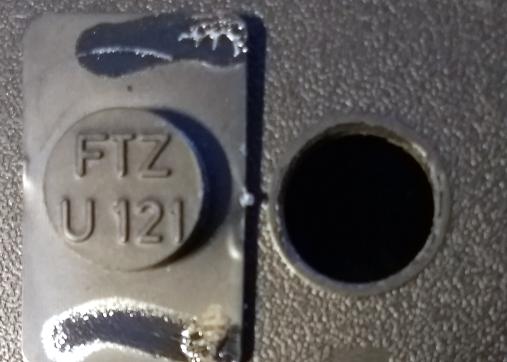
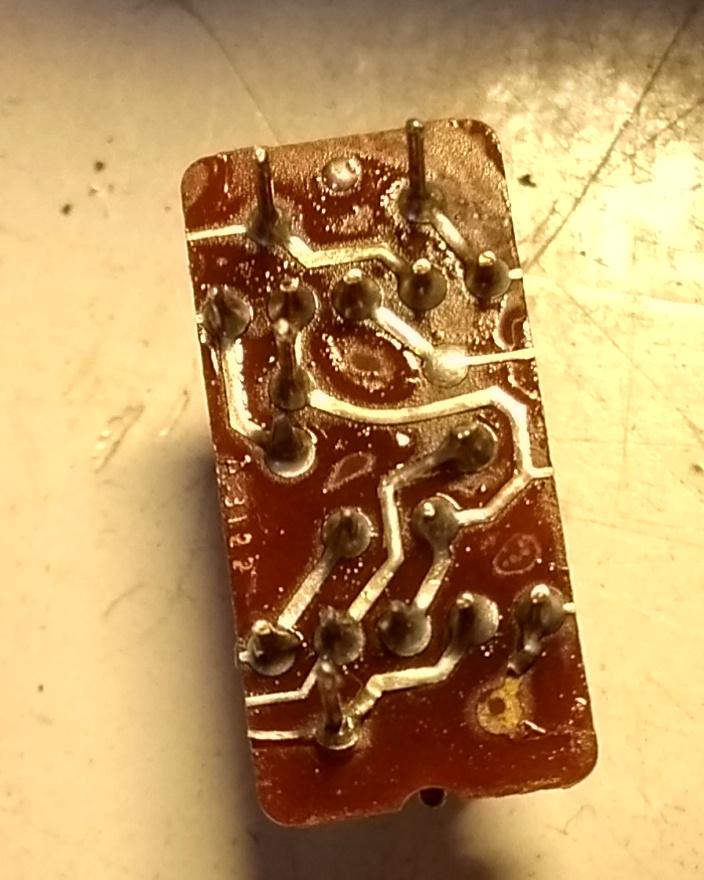 I made a coax antenna plug in the back, the back panel already has a hole for this, because the /07 version comes with antenna jack. The radio couldn't be aligned well, because of a defect, presumably in the IF filter unit U475. It was quite difficult to take out this unit, because of the very small and brittle tracks on the circuit board. The filter unit itself turns out to be again a little PCB in Philps micro style.
I made a coax antenna plug in the back, the back panel already has a hole for this, because the /07 version comes with antenna jack. The radio couldn't be aligned well, because of a defect, presumably in the IF filter unit U475. It was quite difficult to take out this unit, because of the very small and brittle tracks on the circuit board. The filter unit itself turns out to be again a little PCB in Philps micro style.
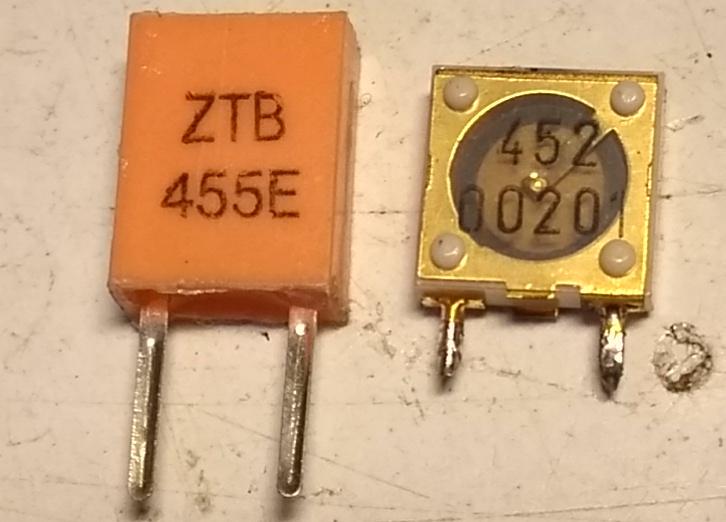
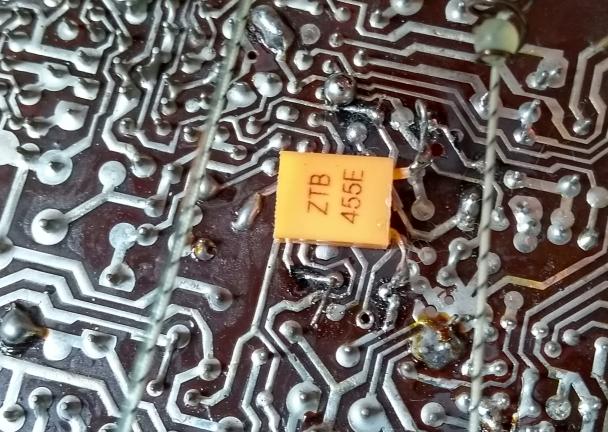 It does not happen often that you have to replace a fifty year old part and the new one is bigger; but here this was the case. Unfortunately, after replacing the resonator and building back the unit, the radio still didn't work well. In the end I decided to bridge the filter unit by a resonator under the PCB (right). But still this didn't work well. So we have a set that works very well on FM, poorly on SW, and not at all on MW/LW.
It does not happen often that you have to replace a fifty year old part and the new one is bigger; but here this was the case. Unfortunately, after replacing the resonator and building back the unit, the radio still didn't work well. In the end I decided to bridge the filter unit by a resonator under the PCB (right). But still this didn't work well. So we have a set that works very well on FM, poorly on SW, and not at all on MW/LW.
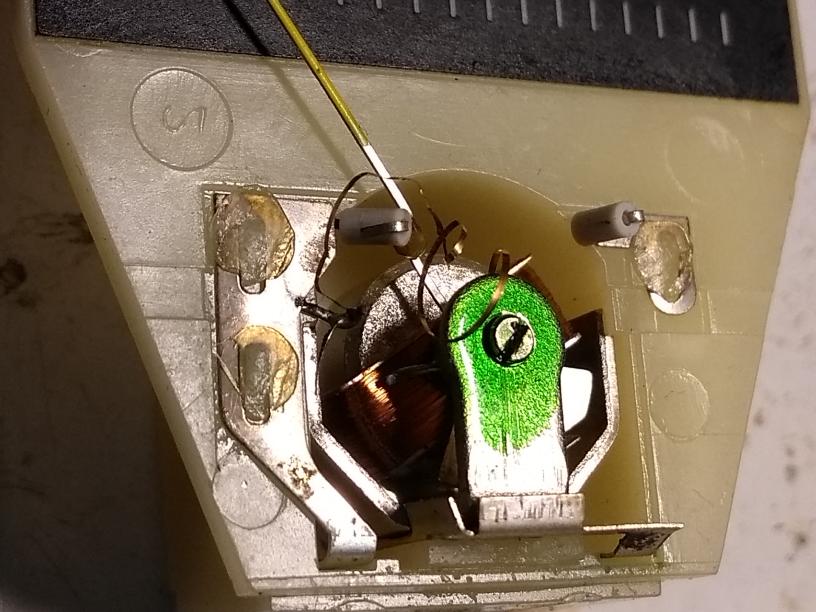 I used one knob and the S-meter to complete my second Hurricane de Luxe. That meter has damaged springs and is placed in this Hurricane (but does not work, of course).
I used one knob and the S-meter to complete my second Hurricane de Luxe. That meter has damaged springs and is placed in this Hurricane (but does not work, of course).
Part of Gerard's Radio Corner.
Generated by SiteBuilder on
26/2/2024
by Gerard
(g.tel@uu.nl)
 on the TBA570 IC. Radio ICs became common in the eighties, and seventies portables were usually equipped with discrete transistors. However, Philips Germany experimented with several models of IC radio's in the early seventies. Although it is fully analogue, it has a feature usually found in digital radio's, namely tuning by voltage and potmeters. FM is tuned with a 100k pot, giving a control voltage that regulates both the FM oscillator and the RF circuit.
on the TBA570 IC. Radio ICs became common in the eighties, and seventies portables were usually equipped with discrete transistors. However, Philips Germany experimented with several models of IC radio's in the early seventies. Although it is fully analogue, it has a feature usually found in digital radio's, namely tuning by voltage and potmeters. FM is tuned with a 100k pot, giving a control voltage that regulates both the FM oscillator and the RF circuit.  The necessary conrol DC voltage of 12.5V is derived from the main power of 9V by a small DC/DC-converter. By switching between four potmeters, you choose the main dial or one of the three presets. The five AM bands are tuned with a classical double variable capacitor, but the fine tuning is also by a potmeter. The photo left shows the three preset pots and the fine tuning pot (top).
The necessary conrol DC voltage of 12.5V is derived from the main power of 9V by a small DC/DC-converter. By switching between four potmeters, you choose the main dial or one of the three presets. The five AM bands are tuned with a classical double variable capacitor, but the fine tuning is also by a potmeter. The photo left shows the three preset pots and the fine tuning pot (top). 

 from 1971 to 1975, mine has an 11/71 date stamp.
from 1971 to 1975, mine has an 11/71 date stamp. 
 The PCB is equiped with miniaturized components, developed by Philips during the sixties. So, as you can see, the PCB only takes a relatively small part of the cabinet. Unlike modern designs, this radio has quite a lot of components that are not placed on the PCB, such as sound and tuning potmeters. So, you'll still find a lot of colored wires in this radio. The look of the radio slightly ressembles the Satellit 1000. Like the Satellits, this 50IC361 has pushbuttons that remain in the cabinet when pulling the chassis.
The PCB is equiped with miniaturized components, developed by Philips during the sixties. So, as you can see, the PCB only takes a relatively small part of the cabinet. Unlike modern designs, this radio has quite a lot of components that are not placed on the PCB, such as sound and tuning potmeters. So, you'll still find a lot of colored wires in this radio. The look of the radio slightly ressembles the Satellit 1000. Like the Satellits, this 50IC361 has pushbuttons that remain in the cabinet when pulling the chassis.

 FM worked fantastic all the time, but the AM bands were dead barring some scratching and I discovered this to be due to a shorted tuning cap. The isolating dielectricum is a dark mica like stuff that brittles. Fortunately, a fellow collector sent me a good cap and I succeeded to bring the AM bands alive with that capacitor. The model was produced with different type of tuning capacitor, where the ones with brownish isolation brittle, and the ones with white isolation are OK. MW and LW remained very unsensitive, unfortunately.
FM worked fantastic all the time, but the AM bands were dead barring some scratching and I discovered this to be due to a shorted tuning cap. The isolating dielectricum is a dark mica like stuff that brittles. Fortunately, a fellow collector sent me a good cap and I succeeded to bring the AM bands alive with that capacitor. The model was produced with different type of tuning capacitor, where the ones with brownish isolation brittle, and the ones with white isolation are OK. MW and LW remained very unsensitive, unfortunately. 
 I made a coax antenna plug in the back, the back panel already has a hole for this, because the /07 version comes with antenna jack. The radio couldn't be aligned well, because of a defect, presumably in the IF filter unit U475. It was quite difficult to take out this unit, because of the very small and brittle tracks on the circuit board. The filter unit itself turns out to be again a little PCB in Philps micro style.
I made a coax antenna plug in the back, the back panel already has a hole for this, because the /07 version comes with antenna jack. The radio couldn't be aligned well, because of a defect, presumably in the IF filter unit U475. It was quite difficult to take out this unit, because of the very small and brittle tracks on the circuit board. The filter unit itself turns out to be again a little PCB in Philps micro style. 
 It does not happen often that you have to replace a fifty year old part and the new one is bigger; but here this was the case. Unfortunately, after replacing the resonator and building back the unit, the radio still didn't work well. In the end I decided to bridge the filter unit by a resonator under the PCB (right). But still this didn't work well. So we have a set that works very well on FM, poorly on SW, and not at all on MW/LW.
It does not happen often that you have to replace a fifty year old part and the new one is bigger; but here this was the case. Unfortunately, after replacing the resonator and building back the unit, the radio still didn't work well. In the end I decided to bridge the filter unit by a resonator under the PCB (right). But still this didn't work well. So we have a set that works very well on FM, poorly on SW, and not at all on MW/LW.  I used one knob and the S-meter to complete my second
I used one knob and the S-meter to complete my second